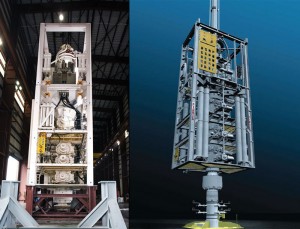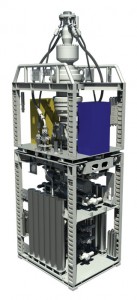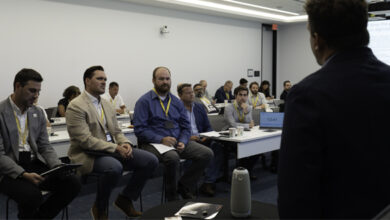Dual BOPs: When one just isn’t enough
By Linda Hsieh, managing editor

On 1 June Rowan Companies announced it had ordered the first two ultra-deepwater drillships in the company’s history, to be built by Hyundai Heavy Industries in South Korea. These 12,000-ft capable vessels will each be equipped with two seven-ram Cameron blowout preventers (BOPs), which means that upon delivery they will be among only a handful of very high-spec rigs in the industry that carry two complete subsea BOP stacks onboard. As both operator and regulator expectations intensify in the deepwater realm, however, the number of “dual-BOP” rigs is likely to grow. In fact, it’s starting to look like deepwater rigs of the future will include a second BOP.
The accommodation of the second stack on Rowan’s drillships started with the overall choice of the hull. “We selected a hull design that offered a tremendous amount of deck space due to being able to integrate riser storage into the hull,” Fred Brooks, Rowan VP of deepwater, said. Moving the riser off the deck opened up areas on deck for storing the second BOP and handling systems to move the BOP to center line, along with having it in a place that can be tested.
“The parking place for the second BOP is fully functional to test the BOP because we also added a second control system that is identical to the primary control system used subsea,” he said. Ensuring stability of the hull was another concern due to the additional million-lb weight that the second stack would bring, Mr Brooks added.
To be able to handle the two-stack configuration, a parking place for the BOP will have to be installed on the drillships, equipped with sea fastening that will allow the stack to be stored. Test stumps also will have to be installed so the BOP can be tested in the parked position, as well as an extension of the tracks to enable the bridge crane to reach the second BOP.
Reducing downtime
The advantages of having dual BOP systems in a deepwater environment, where spread costs for operators run in the range of $1 million/day – are relatively obvious. First and foremost, it can reduce between-well downtime. According to Mr Brooks, two operators have cited savings in the range of $30 million a year in spread costs, assuming they drill four wells a year, by having a second BOP on the rig.
Chevron, which has invested in installing backup BOPs on three of its contracted deepwater rigs – the Discoverer Clear Leader, Discoverer Inspiration and Pacific Bora – said it has already seen positive results from two of the drillships. (The Pacific Bora only just commenced operations in August 2011.)
“Previously it would take between 10 and 14 days between wells, and of that 10 to 14 days, we’d have four to eight days where the rig was just sitting there working on the BOP stack,” Jeff Dieffenbaugher, Chevron senior drilling engineering adviser, said. Now it only takes five to six days between wells, with no time spent just “sitting.” “It makes economic sense for sure,” he said.

Other advantages of having two BOPs have been enhanced in the post-Macondo drilling climate, as new regulations continue to evolve and more stringent maintenance and inspection policies take shape. “Since Macondo, expectations as to the level of maintenance that we conduct on the BOP have gone through the roof. If you can do that off the critical path, you’ve not only saved time but you’ll probably do a better job of it because you’re not in a hurry,” Mr Brooks said. “From a regulator’s point of view, the ability to have dual BOPs on a rig offers some real advantages as far as being able to maintain them to the standards to which we should.”
In Mr Dieffenbaugher’s experience, the post-moratorium BOP certification process has added an extra day or so between wells for Gulf of Mexico rigs. And with the regulations still evolving, he believes the value of having that backup BOP is higher now than ever before.
The caveat, however, is that the drilling contractor must maintain each of those two stacks well, he said. “The success of that second BOP stack boils down to the expertise and how good the subsea BOP equipment team is out there. You can have all the high-tech stuff you want, but you need trained and competent people to make it run,” Mr Dieffenbaugher said.
He also cautioned against keeping a second BOP on the rig as a spare parts store and said all four stacks on the Discoverer Clear Leader and the Discoverer Inspiration are kept fully deployable at all times.
Apparently, keeping two BOPs on offshore rigs isn’t anything new. The industry used to do this decades ago, until bed space became too much of a premium, and there weren’t enough resources and rates to support the practice anymore.

However, back then, the second BOP was kept for spares only, Mr Brooks recalled. “We talked about that a lot at Rowan, and the commitment we had to make internally was that we’re not putting a second BOP on there to be used as a spare parts store. It’s going to be a redundant BOP. It’s a new mindset, and we have to commit to that. Otherwise it won’t work,” he said.
Rigs, BOPs of the future
Looking to the future, Mr Dieffenbaugher said he believes that drilling rigs with two subsea BOPs will become the norm in the industry. “I would be surprised if it doesn’t,” he said.
Other operators appear to be thinking along the same lines. Mr Brooks commented, “We’re talking to the major clients out there, and it’s very clear their expectation going forward would be to accommodate a second BOP.”
Retrofitting existing rigs with a piece of equipment as large and heavy as a subsea BOP stack would be difficult and expensive. Although doable for most rigs, Mr Dieffenbaugher said he believes the industry will lean toward outfitting newbuild deepwater rigs with two-stack configurations rather than trying to retrofit existing rigs.
To be fair, Mr Brooks points out that the industry is already undertaking this task. “A large percentage of the next wave of rigs that are being built by major contractors are installing second BOPs,” he said.
From a BOP manufacturer’s perspective, GE Drilling also said it has seen much more interest in putting second stacks on rigs. Although the challenges of installing two stacks is primarily for the rig designer, GE has worked on innovations that would help operators and contractors take advantage of a two-stack configuration, Chuck Chauviere, GE Drilling president, said.
“On a number of two-stack rigs we have added an interchangeable lower marine riser package (LMRP), which significantly increases flexibility on that rig or possibly across the rig fleet,” Mr Chauviere said. “For example, let’s assume a rig disconnect event occurs. Upon retrieving the LMRP, it is determined that some maintenance is required. Instead of waiting to reconnect while addressing the LMRP, the second LMRP can be landed on the deployed lower stack to resume operations as quickly as possible while working the other LMRP off the critical path.”
GE Drilling has supplied dual BOP stacks with interchangeable LMRPs for two rigs and has orders for three additional rigs.
Innovations around improving the BOP stack itself are also under way. At GE, Mr Chauviere said, a number of new products have been launched this year aimed at increasing the amount and quality of data available from the BOP to display operational information, such as ram position, as well as system health and maintenance information. “This industry approaches product development and introduction in a methodology that provides robust, reliable and repeatable outcomes. Therefore, most change will likely be evolutionary,” he said.
Still, operators like Mr Dieffenbaugher say they would like to see BOP manufacturers do more out-of-the-box thinking, especially when it comes to shearing design. “Shearability is a big issue. Maybe it’s time to look at a different way of shearing or cutting pipe,” he said.





You stated “GE Drilling has supplied dual BOP stacks with interchangeable LMRPs for two rigs and has orders for three additional rigs.”
Could you confirm with 5 rigs these are?
Many thanks
MA